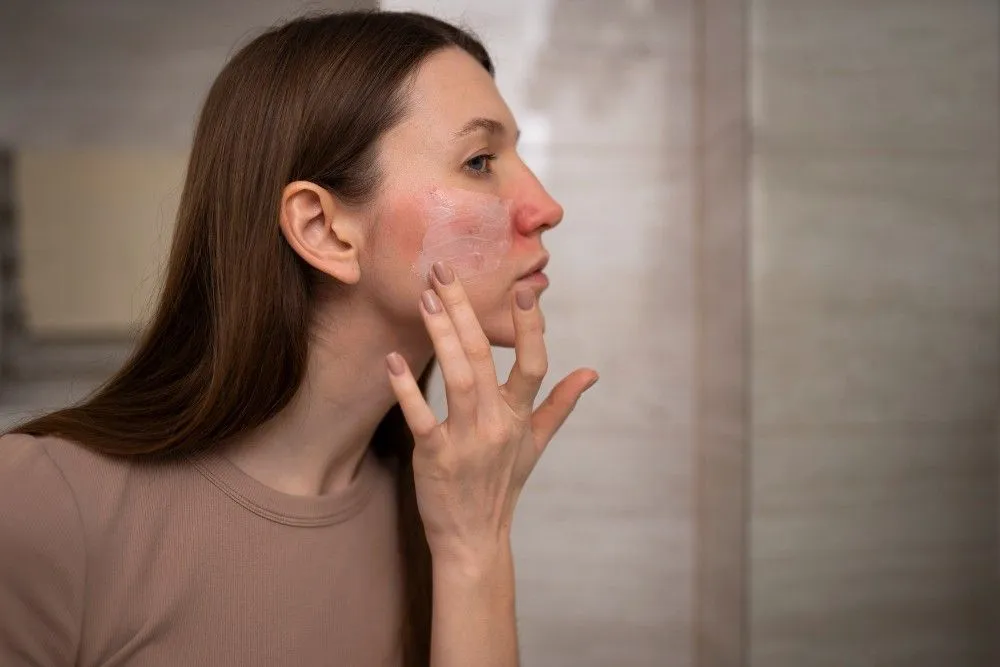Lipomas are soft, fatty lumps under the skin, often harmless but annoying. Many people search for how to remove a lipoma yourself to avoid surgery costs or doctor visits.
But here’s the truth—DIY removal risks infections, scarring, and complications. This guide explains why home methods fail, what professionals do differently, and how to approach treatment safely. Keep reading.
The Hidden Dangers of At-Home Lipoma Removal
Lipomas sit beneath the skin, surrounded by blood vessels and nerves. Removing them without training invites trouble:
- Infection Risk: Home environments lack surgical sterility. Bacteria on tools or skin can infect the wound, leading to abscesses or sepsis.
- Uncontrolled Bleeding: Cutting into the skin blindly can nick blood vessels. Without proper tools or pressure techniques, bleeding becomes hard to stop.
- Nerve Damage: Lipomas near nerves risk permanent numbness or pain if sliced incorrectly.
- Incomplete Removal: Leaving even a tiny piece of the lipoma’s capsule behind guarantees regrowth.
- Scarring: Uneven incisions or poor stitching skills lead to jagged, visible scars.
Bottom line: What starts as a quick fix often ends in ER visits. Never try home-based removal of lipomas.
How Do Doctors Remove Lipomas Safely?
Medical professionals use proven methods to eliminate lipomas with minimal risk:
1. Surgical Excision: Permanent Removal in One Session
Process:
- Numb the area with local anesthesia.
- Make a small cut (1–3 cm) over the lipoma.
- Remove the entire fatty lump and its surrounding capsule to prevent regrowth.
- Stitch the skin closed with dissolvable sutures
Why Doctors Choose It:
- 99% success rate with no recurrence if done correctly.
- Takes 15–30 minutes for most lipomas
Recovery:
- Mild bruising/swelling for 2–3 days.
- Stitches dissolve in 7–14 days.
- Fades to a faint scar in 6–12 months.
Best For:
- Lipomas larger than 2 inches.
- Lumps near joints or sensitive nerves.
2. Liposuction: Scarless Removal for Visible Areas
Process:
- Inject tumescent fluid (saline + numbing agent) to plump up the lipoma.
- Insert a thin tube (cannula) through a 4 mm incision.
- Suction out fatty tissue using a medical vacuum.
Why Doctors Choose It:
- Leaves no visible scars—ideal for face, neck, or hands.
- Less downtime (24–48 hours) vs. surgery.
Drawbacks:
- 10–20% recurrence risk if the capsule stays intact.
- Not effective for firm, fibrous lipomas.
Recovery:
- Wear compression bandages for 2 days.
- Resume work the next day.
3. Steroid Injections: Non-Surgical Option for Small Lumps
Process:
- Inject corticosteroids (like triamcinolone) directly into the lipoma.
- Repeat every 4–6 weeks until it shrinks
Why Doctors Choose It:
- Zero incisions—no scarring.
- Works for patients avoiding surgery (e.g., blood clot risks).
Limitations:
- Only 50% of lipomas disappear completely.
- May cause skin thinning or discoloration.
Best For:
- Lipomas smaller than a grape.
- Patients with multiple small lumps.
4. Laser Therapy: Melt Fat with Precision Beams
Process:
- Use local anesthesia.
- Aim laser energy to liquefy the lipoma’s fat cells.
- Drain melted fat through a tiny puncture.
Why Doctors Choose It:
- Minimal bleeding (lasers seal blood vessels).
- Less post-op swelling.
Recovery:
- Bandage the area for 48 hours.
- Full healing in 1 week.
Best For:
- Lipomas in tight spaces (e.g., behind ears).
- Patients prone to keloid scars.
5. Radiofrequency Ablation (RFA): Heat-Based Removal
Process:
- Insert a needle electrode into the lipoma.
- Emit radio waves to heat and destroy fat cells.
- Absorb dead tissue naturally over weeks.
Why Doctors Choose It:
- No stitches needed—entry point is needle-sized.
- Lower infection risk vs. open surgery.
Recovery:
- Slight tenderness for 3–5 days.
- Lipoma shrinks by 80% in 4 weeks.
Best For:
- Deep lipomas near muscles.
- Patients on blood thinners (less bleeding).
Why Professional Removal of Lipoma is Recommended?
It's because of:
-
Accurate diagnosis, helping determine whether removal is crucial or it's non-cancerous.
-
Proper surgical technique, ensuring complete removal and fewer complications.
-
Post-operative care, like effective wound care and follow-up that ensures a smooth, quick, and safer recovery.
-
Low risk of severe infection by using sterile tools and environments when operating.
-
Analyzing risks related to lipoma removal and discussing them with the patient.
-
Biopsy & lab tests, helping detect the risk of cancer and health issues.
When is Lipoma Removal Necessary?
Removing a lipoma becomes necessary when it:
-
interrupts the normal bodily functions
-
causes cosmetic problems
-
becomes painful or red
-
grows quickly and becomes bigger than usual
-
restricts movement
-
cancerous liposarcoma
Under all these situations, the healthcare providers recommend surgery.
Next Steps:
-
Get an ultrasound to confirm it’s a lipoma.
-
Discuss removal options covered by insurance.
-
Book surgery during colder months to reduce sweating risks.
Never gamble with DIY methods. A 30-minute clinic visit solves the problem safely.
Home Remedies to Reduce Lipomas (But Not Remove Them!)
While no home method can completely remove a lipoma, some remedies might help slow its growth or shrink smaller lumps. Here are a few you can try:
-
Turmeric Paste: Mixing turmeric with olive oil to create a paste and applying it to the lipoma can reduce inflammation and may help shrink the lump. Turmeric is known for its anti-inflammatory properties.
-
Apple Cider Vinegar: Drinking a mixture of apple cider vinegar and water daily may help detoxify the body, potentially reducing the size and growth rate of lipomas.
-
Flaxseed Oil: This oil is rich in omega-3 fatty acids, which are thought to help reduce inflammation. Taking flaxseed oil supplements might help to manage the size of lipomas.
While these remedies can help manage the symptoms of lipomas, they do not provide a cure. Always consult with a healthcare provider for persistent or bothersome lumps.
Home Remedies vs. Professional Care: A Side-by-Side Look
|
Factor |
At-Home Removal |
Professional Removal |
|
Safety |
High infection risk |
Sterile, controlled environment |
|
Pain Management |
None (DIY tools hurt) |
Local anesthesia |
|
Scarring |
Likely severe |
Minimal, neat scars |
|
Effectiveness |
Often incomplete |
Full removal guaranteed |
|
Cost |
Initially cheap, later costly |
Covered by insurance often |
What Happens If You Ignore a Lipoma?
Lipomas are generally safe as they are non-cancerous lumps. However, if left untreated, they may grow and become larger (over 5 cm), which can lead to:
-
pressing on nerves, blood vessels, and muscles, causing pain, numbness, discomfort, or limited movement.
-
inflammation, leading to tenderness, swelling, and redness.
-
changes in the look of the body, leading to self-consciousness.
Moreover, it can become more challenging to remove large lumps later, as it may need complex surgery. This can cause more scarring and lead to a longer recovery.
Important Note: Lipomas don’t turn cancerous, but liposarcomas (cancerous tumors) mimic them and need immediate medical attention. So, always get lumps checked.
A Real Life Story
-
Nick, a 27-year-old boy from Seattle, the United States, gained attention through his YouTube video, which shows his attempt to remove his 7 small lipomas from his leg with the help of only a scalpel and without the use of anesthesia.
-
This incident was presented on the TLC show called "Dr. Pimple Popper" by Dr. Sandra Lee.
-
Nick said he decided to remove the lipoma after researching the process of how to remove lipomas online.
-
He wears the gloves, sterilizes the area, and uses the scalpel to cut the growth of lipomas without anesthesia.
-
This led to significant discomfort and deep scars on his leg.
-
Dr. Lee helped him get rid of his lipomas using effective medical procedures and also educated him about the dangers of self-surgery, like bleeding, scarring, and infection.
Tips to Prevent the Growth of Lipoma
Consider these tips to prevent the growth and recurrence of lipoma:
-
Consume a balanced diet: Have a diet rich in whole grains, fruits, and vegetables, as they lower fat accumulation and prevent the formation of lipomas.
-
Maintain a healthy body weight: Minimizes excessive storage of fat, which might reduce the risk of accumulation of fatty tissues.
-
Limit processed & sugary foods: Lowers inflammation and multiplication of fat cells, which may contribute to the formation of lipoma.
-
Exercise regularly: Boosts fat metabolism, promotes detoxification, and reduces the risk of weight gain, which helps prevent lipoma growth.
-
Avoid alcohol & smoking: Reduces the accumulation of toxins, which may lower the development of abnormal cells.
-
Monitor family history: Research shows that lipomas can be genetic, meaning they can run in families or contribute to genetic syndromes, like Proteus syndrome, PTEN hamartoma tumor syndrome, and Pai syndrome.
-
Detox your liver: Consuming leafy greens and staying hydrated can naturally help detox the liver, which can improve fat metabolism and lower the risk of lipoma.
-
Manage stress: Practice meditation, deep breathing, or yoga to relieve stress, as chronic stress can weaken the immune system and make the body more prone to lipoma formation.
-
Attend health screenings regularly: Helps with early detection of any growth of lipoma and prevents its recurrence with regular monitoring.
Potential Causes of Lipomas
Understanding what causes lipomas can help with effective detection, treatment, and prevention:
-
Genetics: Around two-thirds of lipoma cases show genetic abnormalities. Genetic conditions like familial multiple lipomatosis lead to multiple lipomas.
-
Age: With aging (typically 40 to 60 years), cell regeneration and fat metabolism change, increasing the risk of developing lipoma.
-
Obesity: Increased activity and storage of fat cells encourage the development of lipomas.
-
Injury or trauma to fatty tissue: Triggers fat cell overgrowth, leading to lipoma, and also causes abnormal healing in the affected area.
-
Metabolic disorders (e.g., high cholesterol or diabetes): May affect the processing and storage of fat, causing the formation of fatty lumps.
-
Liver dysfunction: Poor processing of fat by the liver may cause the accumulation of fats under the skin, causing lipoma.
-
Hormonal factors: Hormonal changes during pregnancy, puberty, and menopause may impact lipoma growth.
-
Chronic inflammatory conditions: Examples, adipose tissue inflammation can affect fat tissue, which might create an environment for lipoma growth.
Risk Factors for Lipoma
These factors increase the risk of developing lipoma:
-
High cholesterol
-
Obesity
-
Diabetes
-
Liver disease
-
Glucose intolerance
-
Soft tissue damage from trauma or injury
What Happens If You Ignore a Lipoma?
Most lipomas don’t need removal unless they:
-
Grow rapidly (over 5 cm).
-
Press on nerves or organs, causing pain.
-
Look unsightly (e.g., on the face or neck).
-
Show signs of cancer (rare, but possible).
Note: Lipomas don’t turn cancerous, but liposarcomas (cancerous tumors) mimic them. Always get lumps checked.
Step-by-Step: What to Expect During Professional Lipoma Removal
-
Consultation: A surgeon examines the lump and orders an ultrasound or biopsy if needed.
-
Pre-Op Prep: Avoid blood thinners; fast if general anesthesia is used.
-
Procedure:
- Local anesthesia numbs the area.
- A 1–2 cm incision removes the lipoma.
- Stitches or glue close the wound.
4. Aftercare: Keep the area dry; avoid heavy lifting for 48 hours.
New Developments in Professional Treatments in 2025
1. Ultrasound-Assisted Lipoma Removal:
-
Uses ultrasound to place the local anesthesia, which separates the lipoma for precise removal. It also uses ultrasound to guide liposuction procedures, which helps remove lipoma tissue.
-
Benefits: Minimal scarring and faster healing.
2. Robotic-Assisted Excision:
-
Surgeons guide robotic arms to cut lipoma from nearby tissues, helping with precise incision and minimal damage to nerves and other surrounding tissues.
Benefits: Less pain and bleeding, faster recovery, fewer infection risks, and minimized tissue trauma.
Final Thoughts
Searching for “how to remove a lipoma yourself” might seem tempting, but the stakes are too high. Professional removal takes under an hour, uses safe techniques, and prevents lifelong scars or health issues.
Act Now:
-
Find a board-certified surgeon.
-
Verify insurance coverage.
-
Schedule a consultation.
Share this guide with friends or family considering DIY removal—it might save them from a disaster.
Need Help?
Book a free consultation with top lipoma specialists today. Safe, quick, and covered by most insurance plans.
अक्सर पूछे जाने वाले प्रश्नों
Can lipomas grow back after surgery?
Yes, if the sac isn’t fully removed. Recurrence rates are under 5% with proper excision.
Does lipoma removal hurt?
No. Local anesthesia blocks pain during surgery. Mild soreness lasts 1–2 days post-operation
Will insurance cover my surgery?
Most insurers do if the lipoma causes symptoms. Cosmetic removal usually isn’t covered.
Are there natural ways to shrink a lipoma?
No. Diet changes or supplements don’t affect lipomas. Surgery is the only solution.
How do I know if my lump is a lipoma or cancer?
Only a biopsy or imaging can confirm. See a doctor if the lump is hard, painful, or growing fast.
How long does healing take?
7–14 days for stitches to dissolve. Full recovery takes 3–4 weeks.
Can I exercise after surgery?
Avoid strenuous activity for 1 week to prevent wound reopening.
-User-1754377709.png)
लेखक






